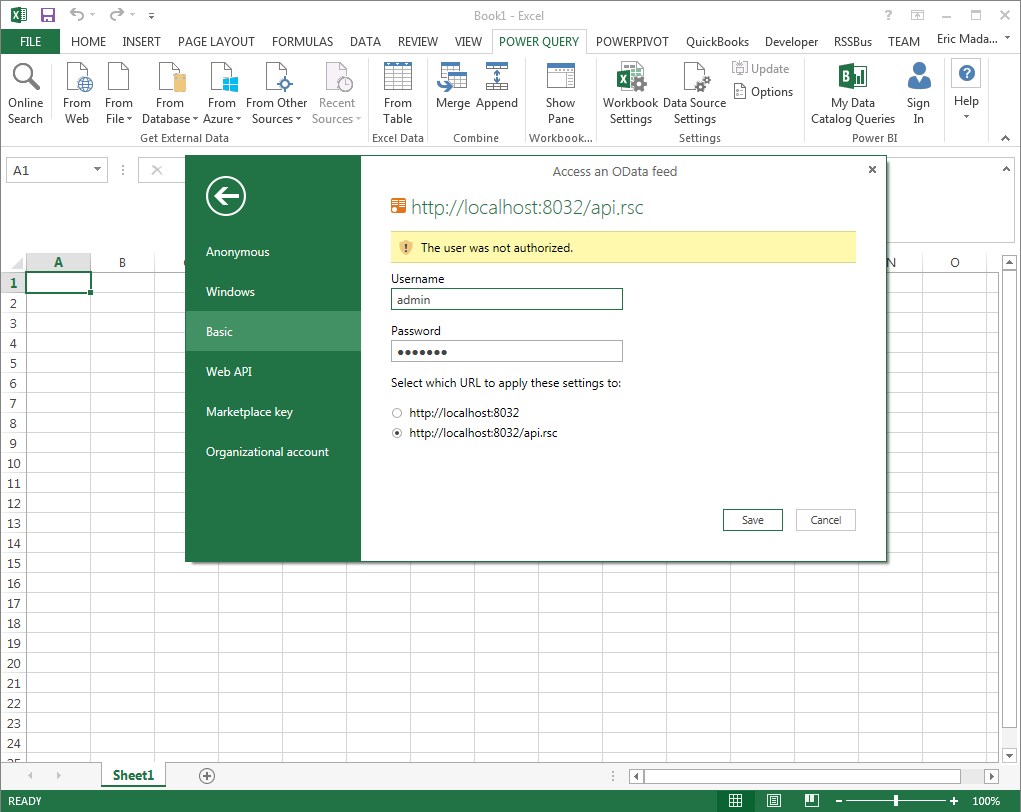Discover how a bimodal integration strategy can address the major data management challenges facing your organization today.
Get the Report →Import REST Data into Microsoft Power Query
The CData Connect Server offers standards-based Web service endpoints that allow a variety of applications to access REST data. In this article, you will use the OData format to import REST data into Microsoft Power Query.
The Connect Server enables you to use Web services to connect to and query REST data. This article details how to import an OData feed of REST data into Microsoft Power Query.
Connect to REST from Power Query
To work with live REST data in Microsoft Power Query, we need to connect to REST from Connect Server, provide user access to the new virtual database, and create OData endpoints for the REST data.
Add a Connect Server User
Create a User to connect to REST from Microsoft Power Query through Connect Server.
- Click Users -> Add
- Configure a User
![Creating a new user]()
- Click Save Changes and make note of the Authtoken for the new user
![Connect Server users]()
Connect to REST from Connect Server
CData Connect Server uses a straightforward, point-and-click interface to connect to data sources and generate APIs.
- Open Connect Server and click Connections
![Adding a connection]()
- Select "REST" from Available Data Sources
- Enter the necessary authentication properties to connect to REST.
See the Getting Started chapter in the data provider documentation to authenticate to your data source: The data provider models REST APIs as bidirectional database tables and XML/JSON files as read-only views (local files, files stored on popular cloud services, and FTP servers). The major authentication schemes are supported, including HTTP Basic, Digest, NTLM, OAuth, and FTP. See the Getting Started chapter in the data provider documentation for authentication guides.
After setting the URI and providing any authentication values, set Format to "XML" or "JSON" and set DataModel to more closely match the data representation to the structure of your data.
The DataModel property is the controlling property over how your data is represented into tables and toggles the following basic configurations.
- Document (default): Model a top-level, document view of your REST data. The data provider returns nested elements as aggregates of data.
- FlattenedDocuments: Implicitly join nested documents and their parents into a single table.
- Relational: Return individual, related tables from hierarchical data. The tables contain a primary key and a foreign key that links to the parent document.
See the Modeling REST Data chapter for more information on configuring the relational representation. You will also find the sample data used in the following examples. The data includes entries for people, the cars they own, and various maintenance services performed on those cars.
![Configuring a connection (SQL Server is shown).]()
- Click Save Changes
- Click Privileges -> Add and add the new user (or an existing user) with the appropriate permissions (SELECT is all that is required for Reveal).
Add REST OData Endpoints in Connect Server
After connecting to REST, create OData Endpoints for the desired table(s).
- Click OData -> Tables -> Add Tables
- Select the REST database
- Select the table(s) you wish to work with and click Next
![Selecting a Table (SQL Server is shown)]()
- (Optional) Edit the resource to select specific fields and more
- Save the settings
(Optional) Configure Cross-Origin Resource Sharing (CORS)
When accessing and connecting to multiple domains from an application such as Ajax, there is a possibility of violating the limitations of cross-site scripting. In that case, configure the CORS settings in OData -> Settings.
- Enable cross-origin resource sharing (CORS): ON
- Allow all domains without '*': ON
- Access-Control-Allow-Methods: GET, PUT, POST, OPTIONS
- Access-Control-Allow-Headers: Authorization
Save the changes to the settings.

Connect to REST Data from Power Query
Follow the steps below to import tables that can be refreshed on demand:
- Configure the Connect Server to use a version of the OData protocol that is recognized by Power Query. In the Connect Server administration console, click Settings -> Server and change the value of the Default Version property to 3.0.
-
From the ribbon in Excel, click Power Query -> From Other Data Sources -> From OData Feed, and enter the OData URL:
https://your-server:8032/api.rsc![The URL of the OData endpoint to consume in Power Query. (SQL Server is shown.)]()
-
Next, define authentication credentials and set privacy levels. Select Basic authentication and enter the credentials for a user authorized to make requests. Specify the Username field and enter the user's authtoken in the Password field.
![The URL to authenticate to and credentials. (SQL Server is shown.)]()
To change the authentication scheme that Power Query will use, click Power Query -> Data Source Settings. Select the OData feed from the list and then click "Edit Permissions..." Select the privacy level from the menu.
![The URL to authenticate to and credentials. (SQL Server is shown.)]()
-
You can now access REST data in Power Query. In the Navigator expand the node for the OData feed, right-click a table, and click Edit to open the Query Editor. This will display the table data.
![Tables loaded in Power Query. (SQL Server is shown.)]()
Free Trial & More Information
If you are interested in connecting to your REST data (or data from any of our other supported data sources) from Power Query, sign up for a free trial of CData Connect Server today! For more information on Connect Server and to see what other data sources we support, refer to our CData Connect page.















